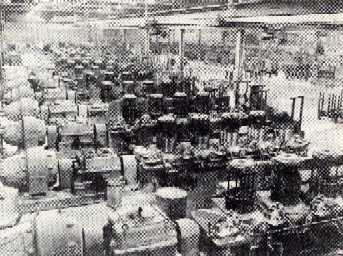|
 "People,
Progress, and Products," the trademark slogan of American Steel
and Wire, is an appropriate way to entitle a section devoted to the
examination and analysis of the economy and industry that shaped the
lives of Quinsigamond Villagers during World War II. We chose to divide
the section into three parts: "Bust to Boom: Leaving the Depression
Behind," "The Arsenal of Democracy," and "Women
Answer the Call." "People,
Progress, and Products," the trademark slogan of American Steel
and Wire, is an appropriate way to entitle a section devoted to the
examination and analysis of the economy and industry that shaped the
lives of Quinsigamond Villagers during World War II. We chose to divide
the section into three parts: "Bust to Boom: Leaving the Depression
Behind," "The Arsenal of Democracy," and "Women
Answer the Call."
In the first section, "Bust to Boom: Leaving the Depression Behind,"
we provided a historic backdrop of the economic ramifications of the
Great Depression in Quinsigamond Village, laying the foundations for
the economic recovery the Village would experience with the onset of
World War II as characterized by the effects of massive defense industrial
mobilization.
 The
next part, "The Arsenal of Democracy," is devoted to the anlsysis
of how industries shifted gears to switch production from civilian to
defensive military needs. It explores the initiatives implemented by
the federal government, the initial resistance of industry, and the
role of the workforce played in achieving the success of the mobilization
effort. The
next part, "The Arsenal of Democracy," is devoted to the anlsysis
of how industries shifted gears to switch production from civilian to
defensive military needs. It explores the initiatives implemented by
the federal government, the initial resistance of industry, and the
role of the workforce played in achieving the success of the mobilization
effort.
Finally, in "Women Answer the Call," we examine the role
and experiences of American women on the home front during World War
II, particularly through their participation in the industrial and military
workforce.
In this section we tried to bridge the overarching link between the
policies enacted by the federal government and the larger historic memories
of the period with the actual experiences of the residents of Quinsigamond
Village whom we interviewed. Sometimes the stories our interviewees
shared with us reflected the greater American home front narrative.
Other times, their memories diverged, and in this way we learned that
in the case of the home front during World War II, as with the rest
of American history, there is no one definitive, historically cohesive
narrative. Instead, the varied experiences of the members of Quinsigamond
community proved to shape the textured fabric of our American experience
of World War II on the home front.

|